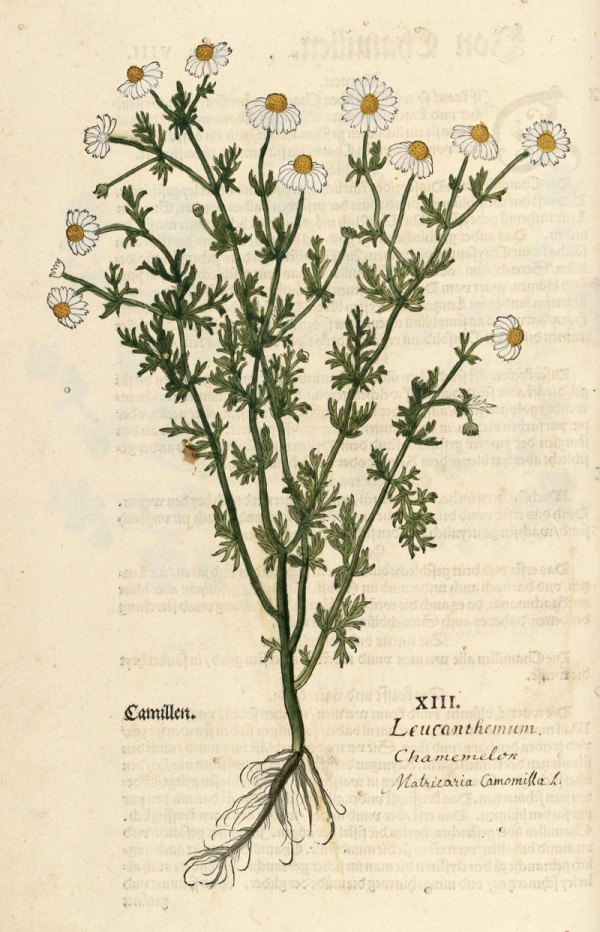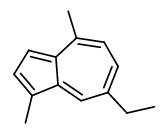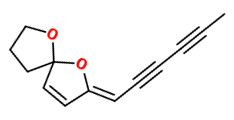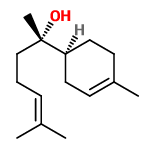Matricaria chamomilla L. - syn. Chamomilla recutita (L.) Rauschert - Asteraceae
wild chamomile, German chamomile, Echte Kamille
Annual herb with branched, erect and smooth stem, up to 15-60 cm high, native to Southeast Europe and adjacent Asia, naturalized in Europe, North America, Australia. Cultivated in Egypt, Argentina and Europe.
M.chamomilla flowers own a attractive and characteristic odor, which is very different from the essential oil of the herb.
A comparison of the constituents of the essential oil (of the bisobolol A chemotype, the more common type in central Europe) and a vacuum headspace concentrate of German chamomile flowers showed some similarities but many differences. Both were high in (E)-β-farnesene (oil 26%, headspace 23%) and bisabolol oxide A (6% vs. 28%), bisabolol oxide B (both 4%), bisabolone oxide (5% vs. 3%).
„The typical odor of German chamomile flowers is attributed to a number of low-boiling components, which occur in the essential oil in only very small amounts, e.g. ethyl and propyl 2-methylbutyrate. These compounds are found in much higher concentrations in the vacuum headspace concentrate of fresh flowers. But methyl salicylate, 2-methoxy-4-methylphenol and indole also contribute essentially to the characteristic chamomile note, even though they are present in very low concentrations. While monoterpene hydrocarbons such as ocimenes and p-cymene appear at comparatively high concentrations in the headspace concentrate, the content of the higher-boiling main constituents generally corresponds to that of the essential oil, with the exception of chamazulene, a known artifact produced only under steam distillation conditions.“
[Surburg et al., Volatile compounds from Flowers, in: Teranishi, R.;Buttery, R. G.;Sugisawa, H. Bioactive volatile compounds from plants. (Book) 1993, 180-183]
„… the headspace concentrate of unpicked chamomile flowers contain a number of volatile monoterpenoids such as 1,8-cineole, p-cymene and artemisia ketone or sesquiterpene hydrocarbons such as caryophyllene, E-β-farnesene and β-selinene at higher concentrations. A number of short chain aliphatic esters like ethyl- and propyl- 2-methyl butyrate, methyl tiglate, ethyl- and butyl isovalerate and cis-3-hexenyl acetate also play an important role in the smell of chamomile, as could be shown by perfumistic reconstituions of the chamomile flower scent.“
Closed loop stripping sampling of living flowers found p-cymene (22.2%), β-selinene (15.9%) and artemisia ketone (10.3%) as main constituents, with 1,8-cineole (8.7%), cis-3-hexenyl acetate (6.9%), ethyl 2-methyl butyrate (6.1%), β-caryophyllene (5.1%), (E)-β-farnesene (4.9%), and propyl 2-methyl butyrate (2.2%).
The dark blue colored chamazulene is an artifact of the steam distillation of German chamomile flowers. The essential oil collected by steam distillation contained bisabololoxide A (57.6%), chamazulene (23.3%), bisabolonoxide A (4.1%), bisabololoxide B (4.3%), (E)-β-farnesene (2.9%), and germacrene D (1.4%). The fruit esters, ocimenes, artemisia keton and β-selinene were only found in traces.
[Brunke E.-J., Hammerschmidt F.-J., Schmaus G., Flower scent of some traditional medicinal plants., in: Teranishi, R.;Buttery, R. G.;Sugisawa, H. Bioactive volatile compounds from plants. (Book) 1993, 282-296]
Extraction of the flowers (4kg) of M.chamomilla with hexane (80g extract) followed by column chromatography yielded mainly the balsamic sweet tonka-scented herniarin (1.76g), oleanolic acid, stigmasterol, ß-sitosterol, and its glucoside.
[Ahmad, A., and L. N. Misra. „Isolation of herniarin and other constituents from Matricaria chamomilla flowers.“ International journal of pharmacognosy 35.2 (1997): 121-125] https://www.tandfonline.com/doi/pdf/10.1076/phbi.35.2.121.13280
„Chamomile has been used for centuries as a medicinal plant mostly for its anti-inflammatory, analgesic, anti-microbial, anti-spasmic and sedative properties… The aqueous and methanolic extracts obtained from chamomile exhibited anti-proliferative and apoptotic activity in various human cancer cells with minimal effect on normal cells. It has been further demonstrated that apigenin glucosides are the major constituent present in chamomile however studies for their development as anticancer agent needs further investigation… It has been demonstrated that the methanolic chamomile extract have high concentration of apigenin-7-O-glucoside along with several polyphenolic constituents which include caffeic acid, luteolin, luteolin-7-O-glucoside among common flavonoids… Methanolic fraction isolated from chamomile flowers demonstrated higher biologic response in inhibiting cell growth and causing induction of apoptosis in various human cancer cell lines compared to aqueous chamomile fraction. Apigenin glucosides inhibited cancer cell growth through deconjugation of glycosides that occurs in the cellular compartment to produce aglycone, apigenin. Taken together, the pharmacological profile of chamomile extract was dependent upon extraction process, storage conditions which affected the biological activity.“
[Extraction, characterization, stability and biological activity of flavonoids isolated from chamomile flowers. Srivastava, Janmejai K., and Sanjay Gupta. Molecular and cellular pharmacology 1.3 (2009): 138]
„Variations in the essential oil composition of Chamomilla recutita (L.) Rauschert from different European countries were determined. A total of 39 components were identified, representing over 92% of the total oil yield. The principal biologically active compounds in chamomile oils were bisabolol oxide A (3.1-56.0%), α-bisabolol (0.1-44.2%), bisabolol oxide B (3.9-27.2%), cis-enyne-dicycloether (8.8-26.1%), bisabolon oxide A (0.5-24.8%), chamazulene (0.7-15.3%), spathulenol (1.7-4.8%) and (E)-β-farnesene (2.3-6.6%). In 8 chamomile samples from 13, bisabolol oxide A (27.5-56.0%) was predominant (among them in three Estonian samples). α-Bisabolol (23.9-44.2%) was predominant in the samples from Moldova, Russia and the Czech Republic. The sample from Armenia was rich in bisabolol oxide B (27.2%) and chamazulene (15.3%). The oils were obtained in yields of 0.7-6.7 mL kg−1 and the minimum limit of 4 mL kg−1 stated by the European Pharmacopoeia was exceeded only in 13 samples from 13 analysed drugs.“
[Content and composition of the essential oil of Chamomilla recutita (L.) Rauschert from some European countries. Orav, Anne, Ain Raal, and Elmar Arak. Natural product research 24.1 (2010): 48-55]
In a comparative analysis, the main constituents found in the essential oils of Matricaria species (inflorescences, Estonia) were:
Matricaria chamomilla (0.15%): Bisabolol oxide A (39.4%), bisabolone oxide A (13.9%), (Z)-en-yne-dicycloether (11.5%), bisabolol oxide B (9.9%), α-bisabolol (5.6%), chamazulene (4.7%);
Matricaria discoidea (0.12%): (Z)-en-yne-dicycloether (37.2%), geranyl isovalerate (22.9%), (E)-β-farnesene (15.6%);
Matricaria perforata (Geruchlose Kamille, 0.2%): (Z,Z)-matricaria ester (77.9%), (E)-β-farnesene (3.5%), matricaria ester isomer (3.5%), matricaria lactone (3.0%).
[Content and composition of essential oils in some Asteraceae species., Raal, A., Kaur, H., Orav, A., Arak, E., Kailas, T., Muurisepp, M., Proceedings of the Estonian Academy of Sciences, Vol.60(1), 2011, 55-63]
http://kirj.ee/public/proceedings_pdf/2011/issue_1/proc-2011-1-55-63.pdf
„α-Bisabolol enters cells via lipid rafts, binds to the pro-apoptotic Bcl-2 family protein BID… α-bisabolol is a pro-apoptotic agent for primary human acute leukemia cells… the pro-apoptotic action of α-bisabolol is not dependent on BID cleavage. However, caspase cleavage is not an absolute requirement for activating BID pro-apoptotic function. Full-length BID is also capable of translocation to the mitochondria, where it has been shown to potentiate cell death following certain apoptotic signals. But we were unable to demonstrate full-length BID in the mitochondria by separating cytosolic and mitochondrial fraction following α-bisabolol treatment“
[Pro-apoptotic activity of a-bisabolol in preclinical models of primary human acute leukemia cells., Cavalieri, E., Rigo, A., Bonifacio, M., de Prati, A.C., Guardalben, E., Bergamini, C., Vinante, F., J Transl Med, Vol.9, 2011, 45]
http://www.biomedcentral.com/content/pdf/1479-5876-9-45.pdf
Main volatile compounds of dried chamomile flowers collected with headspace solid-phase microextraction (HS-SPME) were (E)-β-farnesene (49%), artemisia ketone (10.1%), germacrene D (9.1%) and sabinene (7.7%). Interesting minor components not present in the essential oil (steam distillation-solvent extract, SDSE) were e.g. methyl 2-methylbutanoate (0.3%), ethyl 2-methyl butyrate (1.6%), propyl 2-methylbutanoate (0.5%), benzaldehyde (0.5%), and 1,8-cineole (2.2%). Main components of the essential oil were α-bisabolol oxide A (48.0%), chamazulene (20.4%), (E)-β-darnesene (6.7%) and (Z)-spiroether (6.7%).
[Rafieiolhossaini, Mohammad, et al. „Fast quality assessment of German chamomile (Matricaria chamomilla L.) by headspace solid-phase microextraction: influence of flower development stage.“ Natural Product Communications 7.1 (2012): 1934578×1200700133.]
In chamomile tea, „…at most only 16% of the genuine essential oil can be extracted by infusion. High amounts of spiro ethers [cis- and trans-enyne-dicycloether] (ca.30% in the infusion vs. ca. 12% in the genuine oil) and coumarins (7%) [namely methylumbelliferone 5.5%] and reduced amounts of bisabolol oxides (ca. 32% in the infusion vs. ca. 60% in the genuine oil) can be regarded as markers of the volatile fraction of chamomile tea.“
[Tschiggerl, Christine, and Franz Bucar. „Guaianolides and volatile compounds in chamomile tea.“ Plant foods for human nutrition 67.2 (2012): 129-135]
„Commercial samples of German chamomile (Chamomilla recutita (L.) Rauschert) tea (n = 13), packaged in different countries and purchased in Estonia either at food markets (9) or at retail pharmacies (4), were analysed for the essential oil and terpenoid content and constituents by GC-MS… The oils were obtained from chamomile flowers with yields of 0.10-0.61%… The major phenolic compounds in the chamomile infusions were chlorogenic acids, ferulic acid glycosides, dicaffeoyl quinic acids and apigenin glycosides. Based on the amounts of essential oil, terpenoids, total flavonols and major phenolic compounds, the quality of the commercial chamomile teas was very variable, and the chamomile teas available in pharmacies should be preferred for the medical purposes.“
[Content of essential oil, terpenoids and polyphenols in commercial chamomile (Chamomilla recutita L. Rauschert) teas from different countries., Raal, A., Orav, A., Püssa, T., Valner, C., Malmiste, B., Arak, E., Food Chemistry, Vol.131(2), 2012, 632-638]

Fuchs, L., New Kreüterbuch, t. 14 (1543)
http://plantgenera.org/species.php?id_species=647584
Matricaria chamomilla
© Rolf Marschner (2007),
www.botanische-spaziergaenge.at



